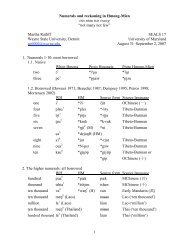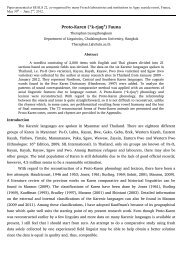proto-southwestern-tai revised: a new reconstruction - seals 22
proto-southwestern-tai revised: a new reconstruction - seals 22
proto-southwestern-tai revised: a new reconstruction - seals 22
You also want an ePaper? Increase the reach of your titles
YUMPU automatically turns print PDFs into web optimized ePapers that Google loves.
Mulao Tone Neutralization 75<br />
While the claim that consonants are directly associated with a tone is contentious 4 , I argue<br />
that consonants and tone form a dependency relationship in the output. This proposal<br />
accounts for the co-occurrence restriction in Mulao, and it also explains consonant-tone<br />
interaction in general.<br />
Formally, consonant-tone interaction results from the requirement that all segments<br />
in the output must belong to a tonal domain, which is ensured by the markedness constraint<br />
ROOTNODE→T (RT→T). This constraint assigns violation marks to segments that do not<br />
belong to any tonal domain in the output (cf. Yip, 2002: 83).<br />
It is crucial to this proposal that there are no faithfulness constraints that preserve<br />
the dependency relationship between tone and consonants. This lack of faithfulness<br />
constraints means that tones are never contrastive on consonants. So, no language will<br />
have a contrast between [pà̀] with low tone on the [p] and [pá̀] with high tone on the [p].<br />
Consonant-tone interaction is the result of markedness constraints dominating tonal<br />
faithfulness constraints. The laryngeally marked elevator consonants affect the tone on<br />
their syllable due to the markedness constraint *ELEVATOR-L (*ELV-L). The *ELEVATOR-<br />
L constraint gives a violation mark to elevator consonants that form a dependency<br />
relationship with a low register tone in the output domain.<br />
The main points of the proposal are summarized in (3).<br />
(3) Proposal<br />
a. Consonants form a dependency relationship with tone.<br />
b. There is no faithfulness constraint that preserves tone on consonants.<br />
c. Markedness constraints<br />
i. ROOTNODE→T: All root nodes in the output should be parsed into a tonal<br />
domain.<br />
ii. *ELEVATOR-L: Elevator consonants should not be parsed into a low<br />
register tone domain.<br />
The tonal faithfulness constraints are proposed in order to specifically target tone<br />
bearing units (TBUs) that are prosodic nodes such as moras (or syllables).<br />
(4) Tonal faithfulness constraints (cf. Yip, 2002: 83)<br />
a. DEP-T The tone associated to a TBU in the output has a corresponding tone<br />
in the input.<br />
b. MAX-T The tone associated to a TBU in the input has a corresponding tone<br />
in the output.<br />
c. IDENT-T The tone associated to a TBU in the output has the same<br />
specification with the correspondent tone in the input.<br />
The representation of a syllable with an elevator onset is shown in (5). Association<br />
lines in this representation indicate the dependency relationship between tone and a<br />
segment (cf. Myers, 1997). Segments associated with the same tone in the output form a<br />
4 The dependency relationship between tone and consonants should be distinguished from the relationship<br />
between tone and prosodic nodes, which are called Tone Bearing Units (TBUs). For a discussion on TBUs<br />
being segments or prosodic nodes, see Bradshaw (1995: 267-269).





